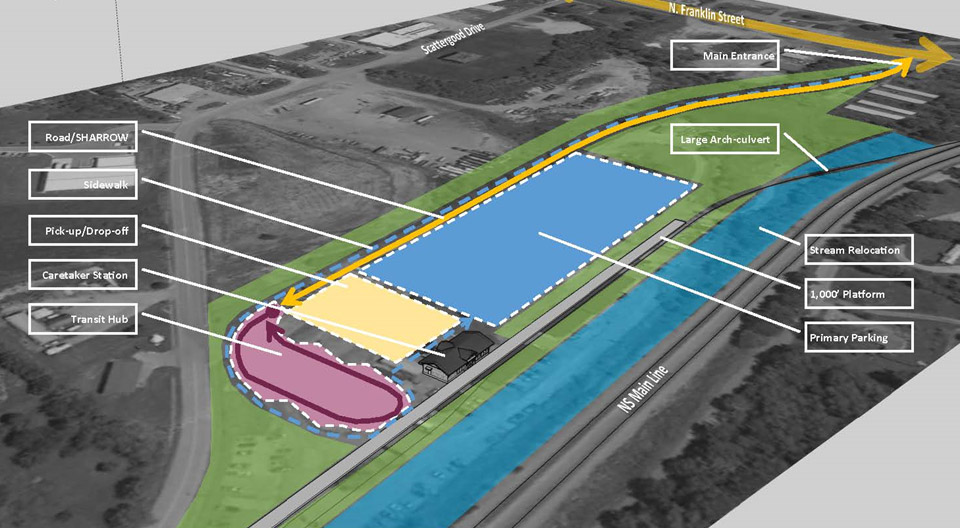.png)
.png)
The purpose of this study is to identify a potential location for a passenger rail station and document the ridership demand in the New River Valley region. The Study process was led by the New River Valley Regional Commission, under contract by the New River Valley Metropolitan Planning Organization (MPO). In general, the MPO is a policymaking organization serving the towns of Blacksburg and Christiansburg, the City of Radford, and the urbanized parts of Montgomery and Pulaski counties. The MPO Technical Advisory Committee (TAC) collaboratively developed site evaluation criteria, reviewed public input, and provided study oversight.
In total, the region has six sites that meet or exceed minimum site requirements for a passenger rail station. The sites are located in Christiansburg, Dublin, Radford, and Pulaski. Quantitative and qualitative factors for each site were rigorously evaluated against up to 32 criteria. On January 7, 2016, the MPO Policy Board recommended that a location, immediately adjacent to North Franklin Street and the Norfolk Southern mainline, in Christiansburg be further explored through an Operational Analysis to determine specific infrastructure needs to offer passenger rail service in the New River Valley.
The New River Valley has a rich history of passenger rail service. The railroad reached what is now Radford in 1854 and scheduled rail service began approximately in 1856. To serve coal mines at Merrimac, in Montgomery County, a branch line connecting Blacksburg and Christiansburg was constructed and began service in 1904. At the height of World War II, there were approximately 12 passenger trains passing through Radford and Christiansburg daily.
In the era before the interstate highway system and widespread car ownership, passenger rail was a common means of intercity travel. The addition of passenger services were a significant improvement over largely unimproved roads in existence well into the 1950s. Passenger rail services declined rapidly through the late 1960s. Regular New River Valley passenger rail service ceased in 1979.
The Commission utilized Amtrak’s Station Program and Planning Guide for initial ridership projections. Based on the New River Valley’s demographic profile, the guide insinuates a potential 20,000 – 100,000 trip generations annually. The guidelines further indicate that the presence of a college or university typically generates comparable ridership to more urbanized communities. In order to determine a more precise estimate, the Commission reviewed Amtrak’s 2014 Service & Ridership Fact Sheets to compare similar communities in Virginia and North Carolina. For the purpose of planning passenger rail site location needs, 40,000 annual trip generations were projected.
April 2015, an online passenger rail survey was launched. The survey captured 6,189 responses before closing in October 2015. Survey feedback included information about travel habits, desirability to use a new service, importance of specific station amenities, and top destinations to points north. The information enabled the Commission to generate a new geospatial database to assess the proximity of potential passenger rail stations to potential north-bound trips. The recommended site(s) in Christiansburg are just a little more than six miles away from 50% of total annual north-bound trips.

According to Virginia Department of Transportation traffic data, the region generates nearly 1,000,000 annual trips to points north on Interstate 81 by vehicle alone. In order to achieve 40,000 annual boardings/alightings, a 4% mode shift from passenger vehicles to rail would need to occur. Alternatively, survey respondents would only need to ride the train 1 out of every 5 trips that they currently make each year.
The final phase of scoring also required a more detailed understanding of existing site characteristics. In addition to generally meeting site requirements, each location needed to accommodate an Amtrak Caretaker Station footprint, 1,000 foot-long platform, 200+ parking spaces, and a regional transit hub. Each location offers unique opportunities and challenges that were further explored during the conceptual planning process. The graphic below illustrates a planning concept for the North Franklin West site in Christiansburg.

In addition to the initial jobs and investment from the construction and ongoing operation of an Amtrak Station, a new passenger rail service would contribute to an array of other economic benefits for the region. These potential benefits include increased tourism and visitor spending, increased business activity in sectors that support tourism and transportation, and more reliable alternatives to highway travel for visitors, regional commuters and university students.
The construction of the station facilities and related infrastructure improvements creates a one-time economic impact during the construction period. Assuming a 2-year construction period, a new station may support 37 jobs and generate more than $1,220,000 in earnings. Once the construction was complete, Amtrak would need to relocate an end-of-the-line crew. The local community would also provide staff support for station maintenance and transit services. In total, a new station would create the equivalent of 8 full-time jobs and $510,000 in annual earnings.
Employment opportunities only reflect a portion of regional impacts. Regions that began offering passenger rail service estimated an increase of 0.5% to 3% of annual visitors. A similar increase in the region would represent 2,500 to 15,000 additional tourists each year. For every 10,000 visitors a new service brings to the region, visitors will spend approximately $1,920,000 in the regional economy, creating 45 additional jobs in hospitality sectors, and generating nearly $900,000 in earnings for regional workers.
Reviewing Local, Statewide, and National level plans and developing case studies is an important component of the planning process. This section provides links to the supporting documents that were reviewed during plan development.
Leaders from throughout Virginia’s New River Valley region are working together to bring passenger rail service to the area by 2020. With AMTRAK passenger rail coming to Roanoke in 2017, community leaders are hopeful that the Commonwealth of Virginia will support extending the service to communities comprising the largest urban concentration west of Roanoke. Click here to follow current efforts.